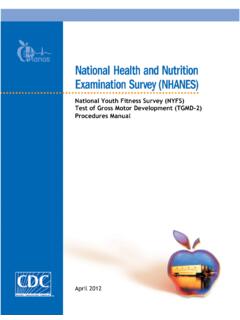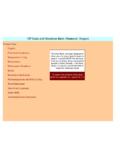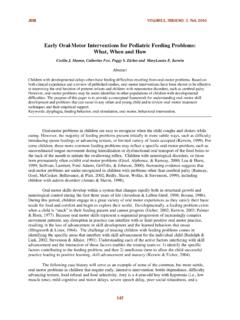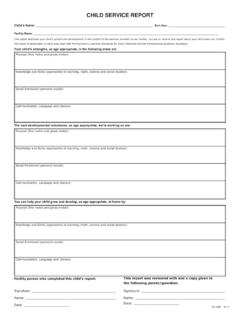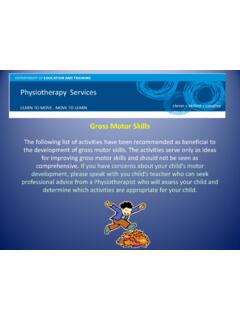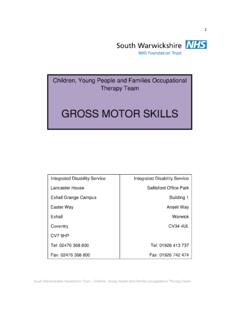Transcription of Motor Development in the Infant and Child
1 Normal and Abnormal Development in the Infant and Pre-School ChildSteven Bachrach, , Cerebral Palsy duPont Hospital for ChildrenDevelopment in the Infant and Child A newborn Infant responds to his or her environment in an involuntary or reflexive way Over the first few years of life, through physical growth and learning experiences, the Child learns to actively participate in the world This Development occurs in a step-wise, sequential manner. These steps along the way are called developmental milestonesDevelopment in the Infant and Child While the sequence of Development is the same for all children, the rate of Development is different for each Child The direction of Motor Development is from head to toe the Child learns to control his head and neck, then his trunk, and eventually his arms and legsDevelopment in the Infant and Child Early Development leads the Infant to master four major types of skills .
2 gross Motor , fine Motor , language and social skills gross Motor skills require the use of large muscles to achieve sitting, crawling and walking in the first year of life Fine Motor skills involve the use of small muscles in the hands and fingers, in tasks such as picking up small objects, and later for feeding and dressing Development in the Infant and Child Language refers to communication skills both the ability to understand others (receptive language) and to express oneself (expressive language) Communication skills are both verbal and non- verbal Social skills are those that describe the Child s interactions with their family and other childrenDevelopment in the Infant and Child The developmental norms we are going to discuss are not absolute there is an age range for each one, as children don t all progress at exactly the same pace A Child may lag in one area of Development such as speech, while making rapid progress on Motor skills , then catch up in language while they plateau on their Motor skillsDevelopment in the Fourth Month The 4 month old begins to roll over, usually front to back first.
3 Back to front closer to 6 months The Infant can now follow movement visually in all directions The Infant is cooing and laughing and smiling spontaneouslyDevelopment in the Sixth MonthThe six month old Infant : Rolls over both ways Sits independently when placed in a sitting position Reaches and grasps a toy Transfers an object from hand to hand Babbles, plays peek-a-boo Begins to show fear of strangersDelayed Development in the Infant Significant delays in early Child Development are a warning sign that something may be wrong Such signs include Inability to hold up the head securely by 3 months Inability to roll front to back and back to front by 6-8 months Inability to sit independently when placed in a sitting position by 8-10 months An Infant who persistently keeps her hands fisted after 4 months Inability to bring an object to her mouth by 6 monthsMotor Development at One Year of Age Most one-year-olds can stand alone, and many are taking their first steps without holding on Many one-year-olds are walking in some combination of standing.
4 Cruising along furniture and taking independent steps Objects held in each hand are banged together The one year old will purposefully release an object from his graspLanguage and Social Development At One Year of Age Says mama , dada and 2 other words May be shy with strangers, will give affection to family members Will start to jargon , speaking with inflection but not in any language the parent understands Will shake head for no Development at One Year The Development of walking (as one example) is affected by the Child s tone and temperament Mildly hypotonic ( loose-limbed ) children will scoot on their buttocks rather than crawl They may well not be walking at 18 months, but by 3 years of age they are walking normallyDevelopment at One Year Temperament affects a Child s Development as well Children who adapt slowly or are temperamentally inactive, may not attempt independent walking even when they are neurologically able to do so Very active babies start taking steps as soon as they can stand.
5 These active infants will later rarely walk once they can runCognition During the First Two Years of Life Object Permanence develops during the first year For a newborn, an object or person doesn t exist when it moves out of sight Between 4-8 months, they will find a partly hidden object By 9-12 months, they will find an object that they see hidden. At this stage they know the parent exists even when not present, but cannot guess where they are and thus protest when separated. At 12-18 months, they can find objects after multiple visible changes of position Play During the First Two Years of Life A Child s play will give evidence of their cognitive Development Playing peek-a-boo signals the Development of object permanence By the first birthday, the Child understands the function of certain objects he will ring a bell and push a car on its wheels Between 18-24 months, he will give his doll a drink, and between 24-30 months, truly imaginative play beginsMotor Development of the Toddler (Age 12-18 Months)
6 The Child begins exploring his environment by using his new-found Motor abilities of crawling and walking Walking is awkward, with arms held high Fine Motor skills allows him to play games, stack objects and make a mark with a pencil or crayon He will drink from a sippee cupMotor Development of the Toddler (Age 18 Months) Walking is more steady She can climb stairs if her hand is held She will attempt to throw a ball She can scribble with a pencil and imitate a vertical stroke She can feed herself with a spoon, and begins using a fork She can build a tower of 3 cubesMotor Development of the Toddler (Age 24 Months) The 2 year old is running well, and falling less often She can kick a large ball She is walking up and down stairs one at a time, while holding a hand She stacks 6 blocks She helps to dress and undress herself She feeds herself with less spilling She can imitate a circular stroke with a pencilMotor Development in the Preschool Years (Age 3-6)By this age children are.
7 Riding a tricycle at age 3, a bicycle with training wheels by age 5 Standing on one foot momentarily by age 3, skipping and hopping on one foot by age 5 Going up stairs alternating feet by age 3, and down by age 4 Feeding themselves much more neatly Putting on shoes and socks by age 3, progressing to full dressing by age 6 Problematic Behaviors Gaze aversion Lack of interest in social interaction Does not seek comfort when stressed Does not greet parent after an absence Lack of interest in toys Excessive fears Pervasive self-stimulatory behaviors (rocking, flapping hands)Language Development The rate and quality of language Development is more sensitive to the Infant s environment than the other parts of Development Infants acquire language only through interaction with responsive people in their environment TV and radio have little to no effect on the Infant s language learning Through games and caretaking rituals during the first year, children learn to take turns communicatingLanguage Development The production of speech is the result of cognitive, oral- Motor and social processes Receptive ability precedes expressive language ability for instance, a Child can point to a picture of a named object before they can say that name During the 2nd and 3rd years of life.
8 Expressive vocabulary expands rapidly: On average, at 18 months they can say 10 words, and by 3 years, 1000 words At 18 months, infants begin putting 2 words together as wellPlay During the Preschool Years Play is used to help children master specific abilities (jumping, throwing a ball etc) Children also use imaginative play to help deal with their fears (fascination with monsters) and with their identification with adult roles (playing house) Play evolves from solitary and parallel play at age 2, to understanding turn-taking at age 3, to interactive and cooperative play at age 4 Play During the Preschool Years Researcher Peter Gray says that children with less play time are more likely to feel anxious, depressed, helpless and narcissistic.
9 Writing in a special issue of the American Journal of Play, he also said children today have less freedom to play than they did 50 years ago. Free play allows children to acquire basic competencies needed as they approach adulthood, including problem solving, decision-making and self controlPlay During the Preschool Years The American Academy of Pediatrics (AAP) recommends that parents limit combined screen time from television, DVDs, computers, and video games to 2 hours per day for preschool-age children. In a recent study, children on average were exposed to 4 hours of screen time each weekday Television viewing in young children has been associated with speech delays, aggressive behavior, and obesity




